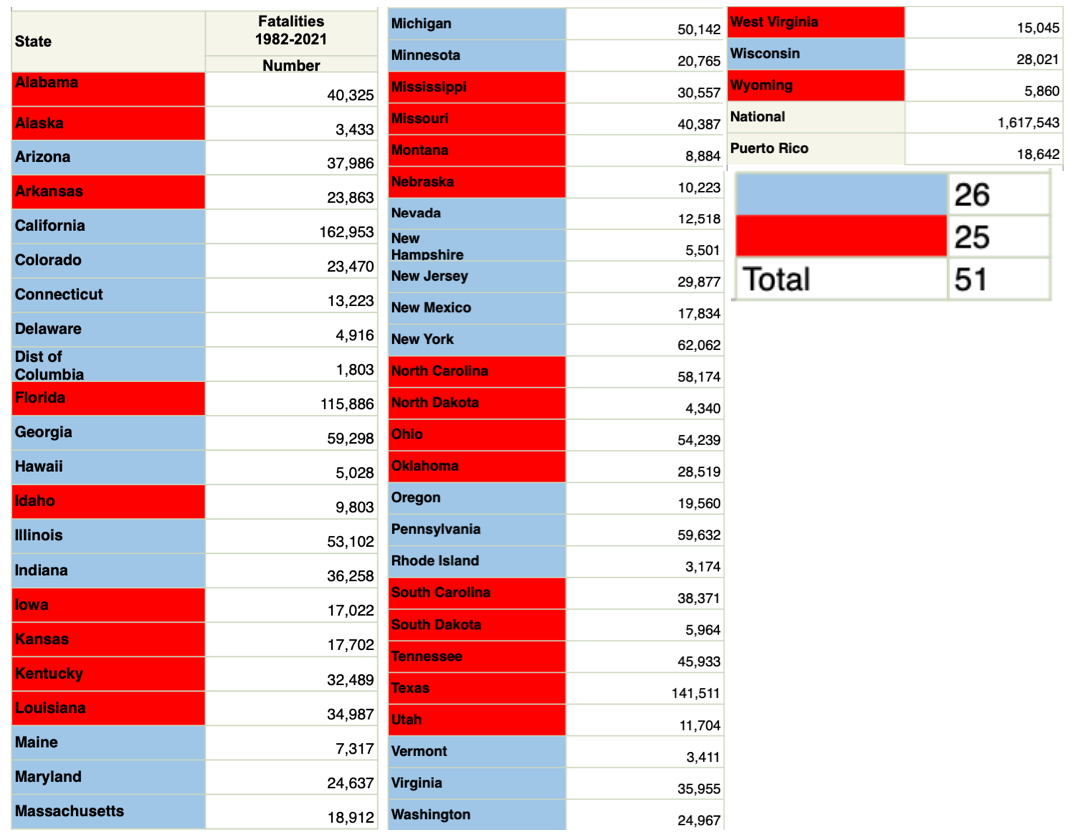NHTSA has long known that we could use crash information to improve emergency care of crash victims.
Consumer Reports reviewed the market for automatic crash notification (ACN) and calls for consumer support for a Federal Standard to be issued by NHTSA.1
A recent article provided NHTSA statistics on fatalities Taken and Not Taken to hospital that conveys the gross enormity of the need for ACN. It shows that NHTSA counted 1,617,543 American lives were lost over the years 1982 – 2021 of crash injuries. Infographic shows the numbers by State.
These people died of their crash injuries either at the scene or after being taken to a medical facility of unknown capability of providing trauma care and/or perhaps too late.2
EMS: Too Little, Too Late, for Too Many Americans
An unknown, but very substantial, number of these crash death victims could have survived with more timely and optimal emergency medical care at the scene, en route, and at a Trauma Center with surgeons and equipment such as fast CT scanners to detect and treat all internal injuries.
NHTSA has known since 1968 of military emergency care experience showing the importance of shortening time to surgery to improve survival rates.3
NHTSA research has shown since the early 1990s how to improve timely optimal emergency medical care for crash victims.4
The technology to provide timely, optimal emergency care is available but presently not legally required nationwide. For decades NHTSA has failed to require instantaneous telecommunication of crash occurrence, type of crash (such as rollover), make and type of vehicle, information on vehicle cut points to facilitate extrication, crash location, injury severity probability, as well as time, distance, and fastest route to the nearest Trauma Center (now calculable by Google).
This information now can be instantly transmitted in seconds for the dispatch of appropriate rescue resources including extrication equipment and personnel, and Medevac when needed for transport to a trauma center.
NHTSA has long known that we could use crash information to improve emergency care of crash victims. A chronological list of NHTSA studies on AACN and URGENCY document the lifesaving potential.5
Which brings us to the question as to why we don’t have such a life saving system. Auto companies have always opposed regulations. See the rollover article on cheaper if they die.6
For Action Let’s Count Costs & Tragic Consequences
The current DOT Value of a Statistical Life is $12.500,000. For the 1.6 million lives lost it would amount to tens of trillions of dollars.7

The years of Potential Life Lost (YPLL) is another measure of consequences that NHTSA has long known about. In a 2001 NHTSA Report (that I edited) on crashes, injuries, emergency care, and outcomes showed that YPLLs of crash deaths were higher than those of cancer and of heart disease. And that Federal research funding on crash deaths was far lower than funding for research on cancer or heart disease.4
NHTSA has also long known that the tragic consequences of crash deaths and injuries have enormous effects on families too – parents, children and many others who love them and need them.8
NHTSA: Do your duty! Care for crash victims. Don’t let them die there.
References (Live Links to Documents):
- Cars That Come With Free Automatic Crash Notifications—And Those That Don’t
- Consumer Reports’ Initiative to Better Save Lives
- Emergency Medical Care and Traffic Fatalities
- CIREN: Crash Injury Research and Engineering Network Program Report
- URGENCY
- Rollover Crashes: Cheaper If They Die
- Departmental Guidance on Valuation of a Statistical Life in Economic Analysis
- Effects On Families


Join the conversation!